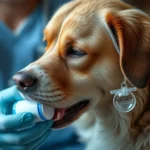
Introduction
Heat stroke in dogs is a serious and life-threatening condition that occurs when a dog’s body temperature rises to dangerous levels, often due to prolonged exposure to high temperatures or strenuous activity in hot weather. Understanding the symptoms, prevention strategies, and treatment options for heat stroke is crucial for every dog owner. This article aims to educate you on how to recognize the signs of heat stroke, what immediate actions to take, and how to keep your furry friends safe during hot weather.
Understanding Heat Stroke in Dogs
What is Heat Stroke?
Heat stroke occurs when a dog’s body temperature exceeds 104°F (40°C), which can lead to cellular damage and organ failure. The physiological process behind heat stroke involves the inability of the dog to cool itself. Dogs primarily regulate their body temperature through panting; when temperatures are too high, panting becomes ineffective. This can lead to heat buildup in the body.
It’s essential to differentiate between heat exhaustion and heat stroke. Heat exhaustion is a milder form of heat-related illness, characterized by excessive panting and discomfort but without severe physiological impairment. If not addressed, heat exhaustion can escalate to heat stroke.
Causes of Heat Stroke
Several factors can contribute to the onset of heat stroke in dogs:
- High Environmental Temperatures: Temperatures above 80°F (27°C) can be dangerous, especially if combined with high humidity.
- Humidity Levels: High humidity can hinder a dog’s ability to cool itself through panting.
- Breed Predispositions: Certain breeds, especially brachycephalic breeds like Bulldogs and Pugs, are more susceptible due to their short snouts.
- Exercise and Activity Levels: Intense physical activity during hot weather can rapidly increase a dog’s body temperature.
- Lack of Access to Water and Shade: Dogs require constant access to fresh water and a shaded area to escape the heat.
Risk Factors
Various risk factors can increase the likelihood of heat stroke:
- Age: Puppies and senior dogs are more vulnerable due to their less efficient thermoregulation.
- Pre-existing Health Conditions: Conditions like heart disease can compromise a dog’s ability to handle heat.
- Obesity: Overweight dogs have more insulating body fat, which can impede heat dissipation.
- Certain Medications: Some medications can affect a dog’s ability to regulate its body temperature.
Recognizing Symptoms of Heat Stroke
Early Signs
Recognizing the early signs of heat stroke can be crucial in preventing severe consequences. Look out for:
- Excessive Panting: Dogs may pant heavily in an attempt to cool down.
- Drooling: Increased salivation can be a sign that the dog is stressed and overheated.
- Restlessness or Agitation: An overheated dog may seem unable to settle down or may pace.
Severe Symptoms
If a dog’s condition progresses, more severe symptoms may manifest, including:
- Vomiting: This can indicate distress and overheating.
- Diarrhea: Gastrointestinal upset may occur as the body tries to deal with heat stress.
- Rapid Heart Rate: An increased heart rate can be a sign of overheating and distress.
- Lethargy or Weakness: If your dog seems excessively tired or weak, it could be a serious sign.
- Loss of Consciousness: In severe cases, dogs might lose consciousness, necessitating immediate action.
Behavioral Changes
Pay attention to any unusual behavior, such as:
- Isolation from Family Members: A dog suffering from heat stroke may seek cooler areas away from people.
- Changes in Appetite and Drinking Habits: Affected dogs may refuse to drink or eat, which can worsen their condition.
Immediate Actions to Take
First Aid for Heat Stroke
If you suspect your dog is suffering from heat stroke, act quickly:
- Remove the Dog from the Hot Environment: Get them to a cooler area immediately.
- Cooling Techniques: Apply wet towels to their body or immerse them in cool (not cold) water to help lower their temperature. Avoid ice-cold water as it can cause shock.
- Monitor Body Temperature: Use a rectal thermometer to check their temperature. If it exceeds 104°F, continue cooling efforts until it drops to a safer level (around 102°F).
When to Seek Veterinary Care
Even if your dog seems to improve, it’s critical to seek veterinary care if you observe:
- Severe symptoms like vomiting, diarrhea, or loss of consciousness.
- Any signs of distress that persist after cooling measures.
- A body temperature that remains elevated.
Professional assessment and treatment can prevent long-term damage and ensure your dog’s health is restored.
Preventing Heat Stroke in Dogs
Safe Outdoor Practices
To minimize the risk of heat stroke:
- Best Times for Walks and Exercise: Schedule walks during the cooler parts of the day—early morning or late evening.
- Importance of Shade and Water: Always bring water for your dog while exercising outdoors, and ensure they have access to shade.
Home Environment Adjustments
Create a comfortable indoor environment:
- Air Conditioning and Fans: Use air conditioning or fans to maintain a cool atmosphere in your home during hot weather.
- Hydration Strategies: Ensure your dog has access to fresh water at all times, and consider ice cubes or frozen treats to help them cool down.
- Safe Indoor Spaces: Designate a cool area in your home where your dog can retreat if they feel too warm.
Breed-Specific Considerations
Certain breeds require special precautions:
- Guidelines for Brachycephalic Breeds: Monitor these dogs closely and avoid strenuous activities in heat.
- Recommendations for High-Energy Dogs: Keep high-energy breeds engaged indoors during hot weather to prevent overheating.
Long-term Health Considerations
Monitoring Health Post-Incident
After a heat stroke episode, keep an eye on your dog’s recovery:
- Signs of Potential Long-term Effects: Watch for unusual lethargy, difficulty breathing, or changes in behavior.
- Regular Veterinary Check-ups: Schedule follow-up appointments to assess any lasting effects on their health.
Weight Management and Fitness
Maintaining a healthy weight and fitness level is vital:
- Importance of Maintaining a Healthy Weight: Obesity can exacerbate heat-related issues, so monitor your dog’s diet and weight.
- Exercise Recommendations for Different Breeds and Ages: Tailor exercise routines to suit your dog’s breed, age, and health status.
Frequently Asked Questions
Can heat stroke be fatal?
Yes, heat stroke in dogs can be fatal if not treated immediately. The longer a dog remains overheated, the higher the risk of serious complications, including organ failure.
How long does it take for a dog to recover from heat stroke?
Recovery time varies based on the severity of the heat stroke and the dog’s overall health. Some dogs may recover within hours, while others may take days or require hospitalization.
Are certain breeds more susceptible to heat stroke?
Yes, certain breeds, particularly brachycephalic breeds like Bulldogs and Pugs, are more prone to heat stroke due to their anatomical structure, which makes breathing and cooling less efficient.
What should I do if my dog shows mild symptoms?
If your dog displays mild symptoms of heat stress, take immediate steps to cool them down and monitor their condition. If symptoms persist or worsen, consult a veterinarian.
Conclusion
Awareness of heat stroke in dogs is essential for all dog owners. By recognizing the signs, implementing preventive measures, and knowing how to respond in an emergency, you can help ensure your dog remains safe and healthy during hot weather. Staying informed and proactive is crucial for your dog’s well-being. Regular check-ups with a veterinarian can also provide tailored advice for your pet’s specific needs.









